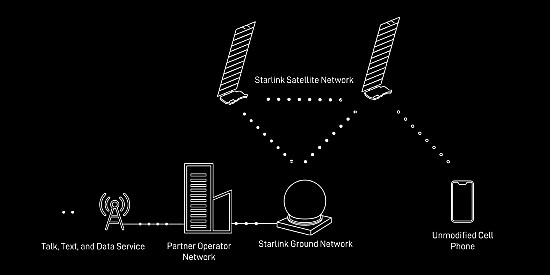SpaceX is changing the way humans use telecommunications technology. Launching the Starlink constellation of satellites in low-Earth orbit has made Internet access universally available across the entire planet. To use Starlink today to access the Internet or make phone calls requires a satellite dish with cable and a modem/router that supports WiFi.
The key to making Starlink coverage work comes with the number of satellites SpaceX has put into orbit and the ones it plans to add. As of last month, more than 5,500 were circling the planet. Global coverage will require approximately 6,500 more.
SpaceX eventually wants its constellation to grow to 42,000 with a variety of satellite types to provide different levels of service. Some of the satellites will be deployed using a higher level of security to meet U.S. military requirements. It was recently tested in the Arctic and is being called Starshield.
The closest parallel to Starlink, before it arrived, was the deployment of geostationary satellites to beam television signals to homes equipped with dishes. Satellite TV uses satellites placed in geosynchronous orbit. Geosynchronous orbits are at a distance where the satellite travels at a speed that aligns with the rotation of the planet to make it appear stationary. Starlink satellites orbit at much lower levels and do not maintain the same positional orientation as receivers on the ground. With Starlink, a signal sent to it is shared by the next satellite to provide a continuous connection.
Starlink doesn’t have one type of satellite. Concern by astronomers has led to cosmetic changes to make the satellites dark against the night sky. The astronomers were complaining that the satellites were interfering with the night viewing of stars and planets.
Recently, Starlink developed two new satellite versions with the designation V2 (not to be confused with Nazi Germany’s V2 rockets which were used to bomb London in World War Two). The two versions are designated large and mini. The former has yet to be deployed because it has been designed for future launches on SpaceX’s Starship. The other is called the V2 Mini. But it is far from small being three times heavier at 800 kilograms (1,760 pounds) compared to prior Starlink satellites. The V2 Mini provides faster feeds and speeds to improve network performance which has started to experience slowdowns as more customers sign up.
The V2 Mini series has decreased the number of satellites that each Falcon 9 can put into orbit. Where 60 of the older Starlink satellites at a time could be put into orbit. Now, each Falcon 9 flight carries a maximum of 21.
How Calling Works with Starlink Currently and in the Future
How calling on Starlink works today is similar to placing a phone call using your home WiFi network and an app like WhatsApp. This type of connection is called Voice-over-Internet-Protocol (VoIP). If you are too far from the WiFi router, the phone call will not connect. If away from your home network you are not able to make direct phone calls using the Starlink network unless doing it from another Starlink-connected location with shared network access.
That’s about to change if the current Federal Communications Commission (FCC) pilot project passes muster. The goal is to provide direct-to-cellular communications between everyday cellular phones and the second generation of Starlink satellites. The current trials involve 840 satellites with direct-to-cellular payloads with approximately 60 serving handsets in the United States. The U.S. carrier, T-Mobile is the testbed.
In October, Starlink began to advertise a Direct-to-Cell phone service providing voice and text in 2024 and data services in 2025. It intends to expand coverage to include carriers in Canada, Australia, New Zealand, Switzerland and Japan.
Current U.S. carriers other than T-Mobile have been filing complaints with the FCC about direct-to-cell service stating it could disrupt ground-based wireless connections that use land-based cellular towers.
The V2 Mini satellites are the ones supporting the Direct-to-Cell pilot project. Each is equipped with an advanced eNodeB modem that acts like a cellphone tower located in space which allows for network integration similar to standard roaming, a feature of land-based telecommunications networks. The concern expressed by carriers other than T-Mobile is that the antennas onboard the V2 Minis could transmit and receive calls that interfere when placed in proximity to land-based cellphone towers operated by other phone and Internet providers. The pilot is scheduled to last 180 days and should prove or refute this concern.
The Implications of Direct-to-Cell Telecommunications
If telecommunications can be liberated from being tied to land-based networks, it means uninterrupted coverage over the entire planet for not just cell phones but also Internet-of-Things (IoT) devices. It means access from anywhere including remote locations where currently there is no cellular coverage.
Is this new? No. The Iridium network uses its satellites and 400,000-plus specialized handsets to serve its customers. But what Starlink is providing does away with the need for an expensive second cellphone.
Considering the ubiquitous use of inexpensive smart cellphones today amounting to close to 6 billion, Starlink Direct-to-Cell will be as revolutionary as the first deployed terrestrial cellphone network was in Japan back in 1979.









“But what Starlink is providing …”
Starlink isn’t providing anything yet, it has just begun testing, something both Lynk and AST Spacemobile did more than a year ago. Starlink is not pioneering, they are chasing from behind.
So far, Starlink has claimed a successful D2C text message. No standards based 2G, 3G, 4G LTE, or 5G. In stark contrast, AST Spacemobile has successfully demonstrated all of those standard, including broadband data transmission at 40Gbps — something Starlink’s V2 satellites will never be able to do.
It’s good for everyone that Starlink has decided to join the race to providing D2C service, but an article like this is completely devoid of context if it omits the pioneering work that AST Spacemobile has done, and more importantly, the lead it has in the race to provide voice, video and full broadband.
I am glad to be corrected by a reader who brought to my attention the work being done at SpaceMobile. Last November they launched a prototype satellite to demonstrate direct-to-cell telephony. The company plans to put a constellation of Bluebird satellites into orbit to allow unmodified phones and tablets to upload and download data and voice. No dates are mentioned for when the Bluebirds will be flying. The Texas-based company is directly competing with SpaceX its Texas and California-based rival.